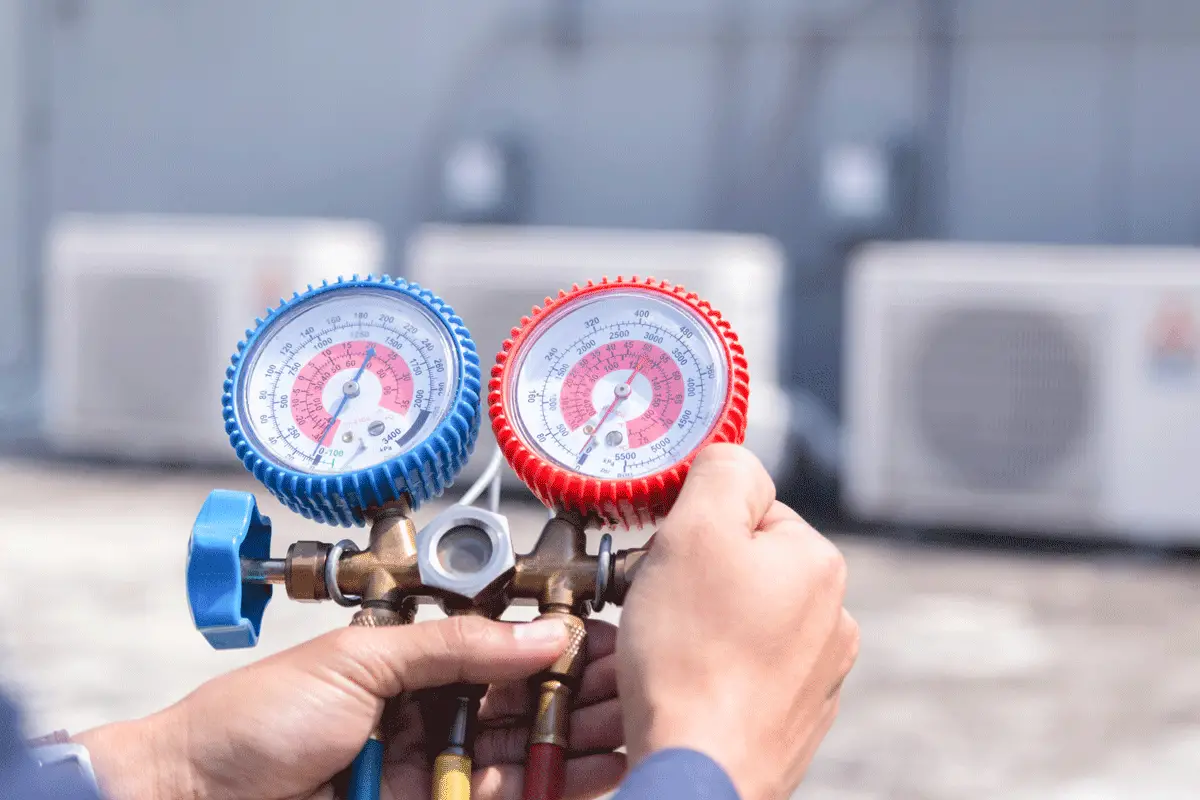Efficient and reliable refrigeration is an essential part of our lives. But you may be wondering about the flammability of the chemicals used in heating and cooling systems.
Are refrigerants flammable? If so, what makes them catch fire and burn?
This article dives into the varying flammability classifications of refrigerants used in modern appliances, exploring potential safety concerns and best practices for informed use.
Are Refrigerants Flammable?
Most refrigerants used historically were flammable; however, many refrigerators today are not flammable. Modern air conditioning systems and heat pumps use refrigerants classified as A1 according to the ASHRAE 34 standard, meaning they are non-flammable.
Refrigerant Flammability Classifications
Today, refrigerants are classified based on their flammability according to the ASHRAE Standard 34. Here’s a breakdown of this classification system in a refrigerant flammability chart:
| Flammability Classification (ASHRAE 34) | Flammability | Example Refrigerants |
|---|---|---|
| A1 | Non-flammable | R-10 to R-14, R-21 to R-22, R-113 to R-115, R-123, R-1234zd, R-134a, R-410A, R-449B, R-765, |
| A2L | Low flammability | HFO-1234yf, HFO-1234ze, R-32, R-152a |
| A2 | Flammable | R-30, R-40, R-142b, R-152a, R-611, R-717 |
| A3 | Highly flammable | R-50, R-170, R-290, R-600a, R-441a, R-1140, R-1270 |
What Makes Refrigerants Flammable?
The flammability of a refrigerant depends on its chemical composition and properties. Here’s a breakdown of the key factors:
- Hydrocarbon Chain Length: Hydrocarbon refrigerants, like propane (R-290) and butane (R-600a), have a longer carbon chain structure compared to some non-flammable refrigerants. These longer chains tend to be more easily vaporized and can readily form flammable mixtures with air.
- Chemical Bonds: The specific arrangement of atoms and the types of bonds within a refrigerant molecule influence its flammability. Single bonds between carbon and hydrogen atoms are generally more susceptible to combustion than double or triple bonds.
- Ignition Temperature: This is the minimum temperature at which a refrigerant’s vapors will ignite when exposed to a spark or flame. Lower ignition temperatures indicate a higher flammability risk.
- Air-Fuel Ratio: For combustion to occur, a specific ratio of fuel (refrigerant vapor) and oxygen (from the air) is necessary. Refrigerants with a propensity to create a flammable mixture with air at room temperature are more likely to be classified as flammable.
In simpler terms, the combination of a hydrocarbon structure, specific chemical bonds, and a low ignition temperature can make a refrigerant more susceptible to burning in the presence of air and an ignition source.

Safety Procedures for Working With Flammable Refrigerants
Due to the flammability risk of refrigerants, special safety procedures are essential when working with these systems:
- Training and Certification: In many regions, technicians require specific training and certification to handle flammable refrigerants. This ensures they understand the risks and proper handling procedures.
- Working in a Well-Ventilated Area: Always work in a well-ventilated space to prevent refrigerant buildup and potential ignition.
- Spark-Free Tools: Use only tools specifically designed for working with flammable refrigerants to minimize the risk of sparks.
- Leak Detection and Repair: Regular leak detection and prompt repair of any leaks are crucial to prevent flammable refrigerant from accumulating and creating a safety hazard.
- Emergency Procedures: Be familiar with emergency procedures in case of a leak, such as evacuating the area and contacting qualified professionals for assistance.
Remember: If you’re unsure about any aspect of working with flammable refrigerants, it’s always best to err on the side of caution. Leave servicing and repairs to a qualified HVAC technician who has the training, experience, and equipment to handle these systems safely and effectively.
How do I know if a system uses flammable refrigerants?
Here are several ways to check if a system uses flammable refrigerant:
- Check the Data Plate: This plate on the air conditioner or heat pump often lists technical specifications, including the refrigerant type.
- Check for a Flame Symbol: Systems using flammable refrigerants are required to have a warning symbol. It will contain a yellow triangle with a flame in the center.
- Check for Red Tubing: Systems using flammable refrigerants should have a red colored tube at the refrigerant process tubing and service ports.
- Owner’s Manual: The appliance’s owner’s manual should contain information about the type of refrigerant used (look for a refrigerant designation like R-290 for propane or R-717 for ammonia).
- Consult a Qualified Technician: If you’re unsure after checking the visual indicators and manual, it’s best to contact a qualified HVAC technician. They can inspect the unit and identify the refrigerant based on its properties or service markings.
Summary
In many cases, refrigerants are not flammable because modern refrigerants have been manufactured to non-flammable. However, some exceptions exist, especially with older systems, and it’s important to be aware of the potential risks.
